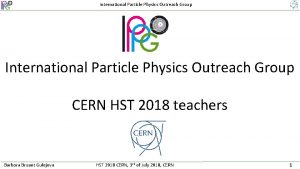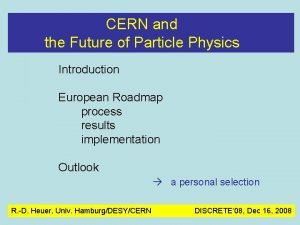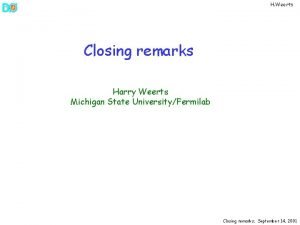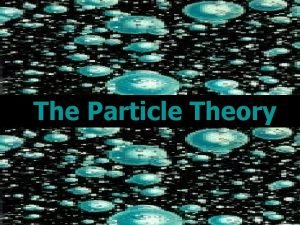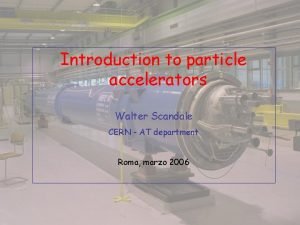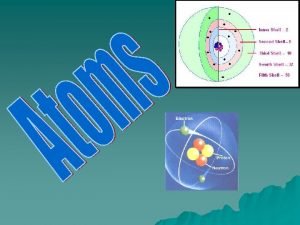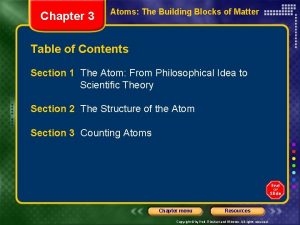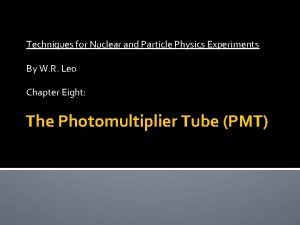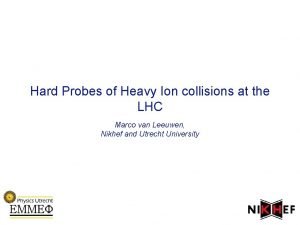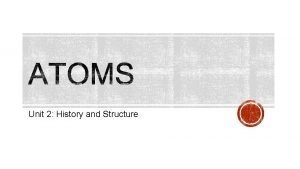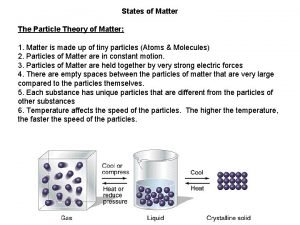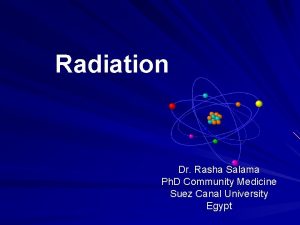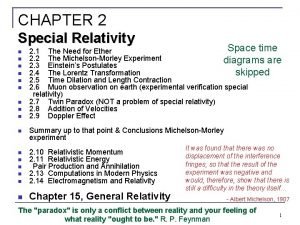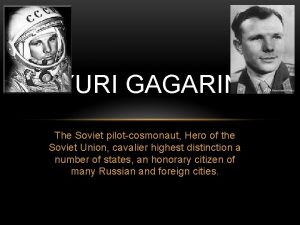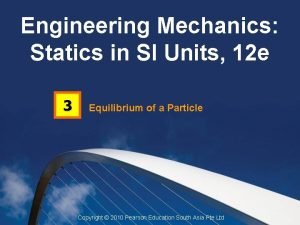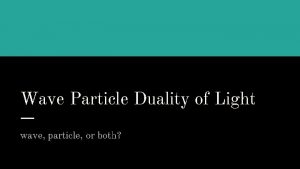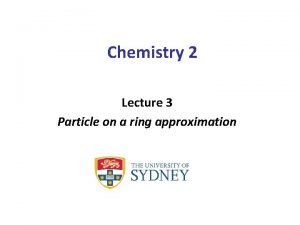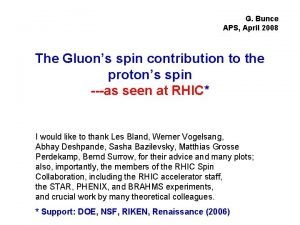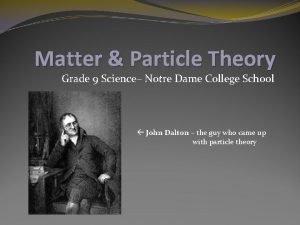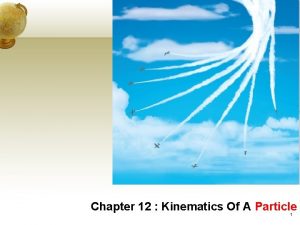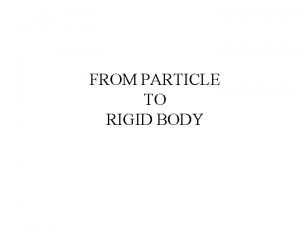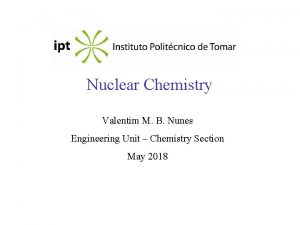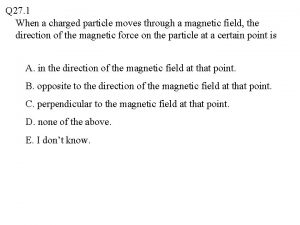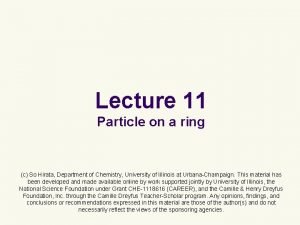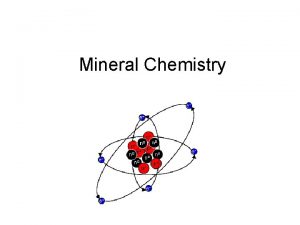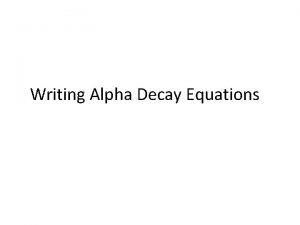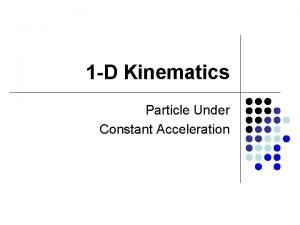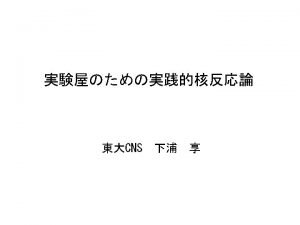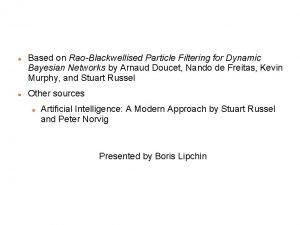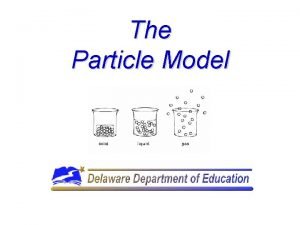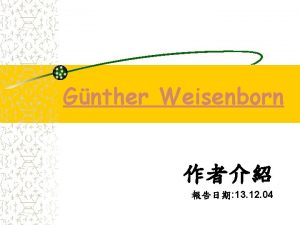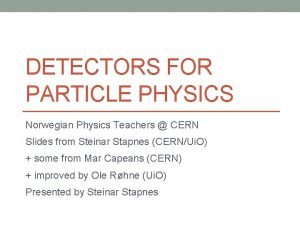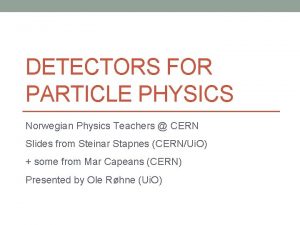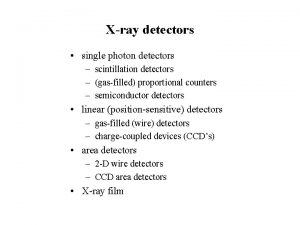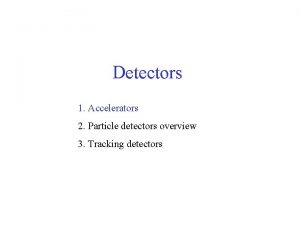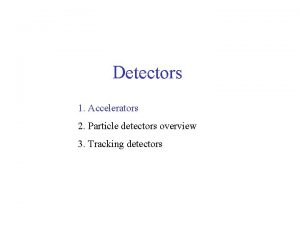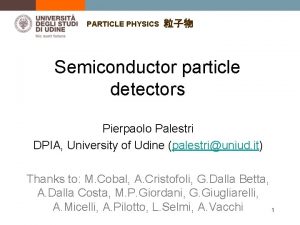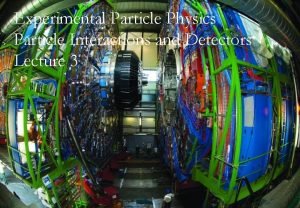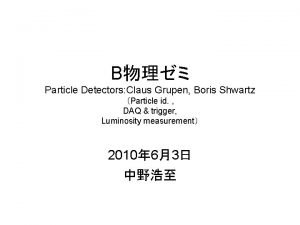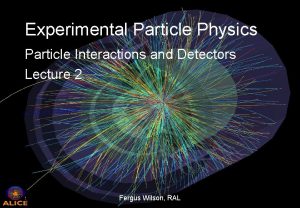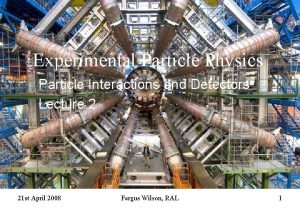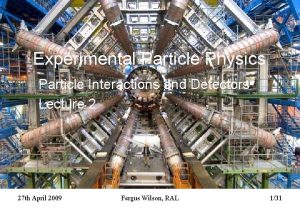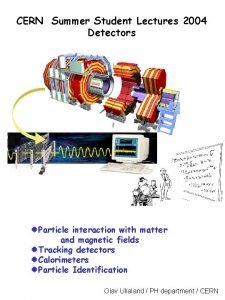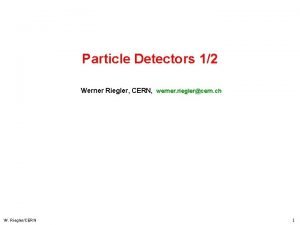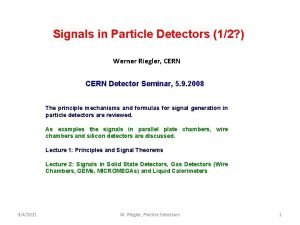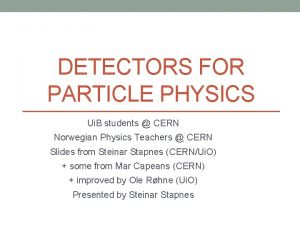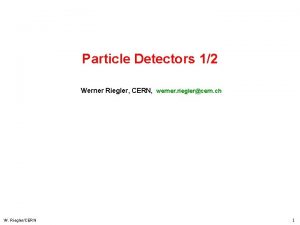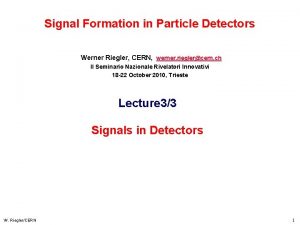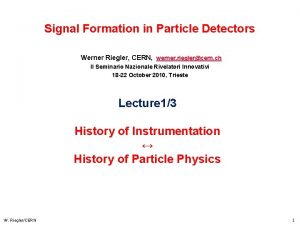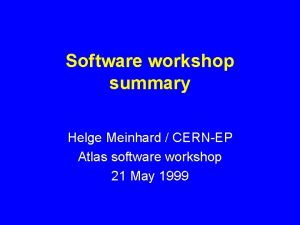PARTICLE DETECTORS Gnther Dissertori CERNEP CERN Teachers Seminar



















































- Slides: 51

PARTICLE DETECTORS Günther Dissertori CERN-EP CERN Teachers Seminar July 2001

Outlook z Introduction z What to measure, why? z Basic Principles y Tracking y Calorimetry y Particle Identification z Large detector systems z Conclusions

Introduction z HE physics experiments study interaction of particles y by scattering of particles on other particles z Results of these interactions are y change in flight direction/energy/momentum of original particles y production of new particles

Introduction. . . z These interactions are produced in Detector elements 1 2 p 1 = -p 2 = 0 1 2 z Goal : measure as many as possible of the resulting particles from the interaction y put detector “around” the interaction point

What to measure, why? z If we have an “ideal” detector, we can reconstruct the interaction, ie. obtain all possible information on it. This is then compared to theoretical predictions and ultimately leads to a better understanding of the interaction/properties of particles z “Ideal detector” measures y all produced particles y their energy, momentum y type (mass, charge, life time, Spin, decays)

Measured quantities z The creation/passage of a particle ( --> type) Electronic equipment eg. Geiger counter z Its four-momentum px p = py pz z Its velocity b = v/c Energy momentum in x-dir momentum in y-dir momentum in z-dir E = p

Derived properties z Mass y in principle, if E and p measured: y if v and p measured: E 2 = m 2 c 4 + p 2 c 2 p = m v / (1 - b 2) E 1, p 1 y from E and p of decay products: x m 2 c 4 = (E 1+E 2)2 - (cp 1+ cp 2)2 m E 2, p 2

Further properties. . . z The charge (at least the sign…) y from curvature in a magnetic field Negative charge Magnetic field, pointing out of the plane positive charge z The lifetime t y from flight path before decay length

So, how measure the four-momentum? z Energy : from “calorimeter ” (see later) z Momentum : y from “magnetic spectrometer+tracking detector ” Negative charge Lorentz-force Magnetic field, pointing out of the plane q v B = m v 2/R p 2 R 1 p 1<p 2 R 1 < R 2 p 1 positive charge q B R = m v= p z velocity : y time of flight L or Cherenkov radiation (see later) vt=L

Principles of a measurement z Measurement occurs via the interaction (again…) of a particle with the detector(material) y creation of a measureable signal x Ionisation e- p x Excitation/Scintillation g e- p x Change of the particle trajectory p • curving in a magnetic field, energy loss • scattering, change of direction, absorption p

Detected Particles z Charged particles y e -, e +, p (protons), p , K (mesons), m (muons) z Neutral particles y g (photons), n (neutrons), K 0 (mesons), y n (neutrinos, very difficult) z Different particle types interact differently with matter (detector) (eg. photons do not feel a magnetic field) y need different types of detectors to measure different types of particles

Typical detector concept z Combine different detector types/technologies into one large detector system Muon detectors Magnetic spectrometer Hadronic calorimeter Precision vertex detector tracking detector Electromagnetic calorimeter Interaction point



Electron e- Photon g Hadron, eg. proton p Muon m- Meson K 0 sy ste m Mu de on t sy ecto ste r m Ele ca ctrom lor im agn ete eti c r Ha ca dron lor i im c ete r ing ck Tra

Tracking Detectors z Basic goal: goal y make the passage of particles through matter visible --> measure the tracks y Reconstruct from the measured space points the flight path y Extract information on the momentum (see previous transparencies) y NOTE: the particle should not be too much affected by the detector: No dense materials !

This is achieved by z Detectors where y Ionisation signals are recorded x x Geiger-Müller counter MWPC (Multi-Wire Proportional Chambers) TPC (Time Projection Chamber) silicon detectors x Bubble chambers (see separate lecture) y Scintillation light is produced x eg. scintillating fibers

Principle of gaseous counters cathode signal Anode + HV - -++ - + - + t=0 + + ++ -- -- + - t = t 1 Wire Gas-filled tube F Track ionises gas atoms F electrons drift towards anode, ions towards cathode F around anode electrons are accelerated (increasing field strength) F further ionisation --> signal enhancement --> signal induced on wire

Principle of gaseous counters. . . gas filling

Now : Tracking z Basic idea : put many counters close to each other Anode wires Cathode: pads or wires Realization: wire chamber (MWPC) Nobel prize: G. Charpak, 1992 y x

Tracking: MWPC ITC (ALEPH) Inner Tracking Chamber

Further development: Time Projection Chambers (TPC) MWPC E - - B + - + + - - - + -+ + er lind y c d e as-fill G z = vdrift t gives r, f Anode Wires

TPC

Limitations z Precision limited by wire distance Error on space point d Uncertainties on space points cannot be reduced arbitrarily! Uncertainties on track origin and momentum

Step forward: Silicon Microstrip Detectors 0. 2 - 0. 3 mm Silicon wafers, doped Creation of electron-hole pairs by ionising particle Same principle as gas counters Now precision limited by strip distance 10 - 100 mm

Silicon microstrip detectors. . .

Silicon Microstrip detectors. . . OPAL VDET ALEPH VDET Future ATLAS tracking detector

Increase in precision =Beam crossing point 0 x 1 cm

Mean Lifetime of tau t=290 x 10 -15 sec !! --> ct = 87 mm !?

Scintillating fibers z Certain materials emit scintillation light after particle passage (plastic scintillators, aromatic polymers, silicate glass hosts…. ) Total reflection PM Photomultiplier: converts light into electronic signal Scintillating material Put many fibers close to each other --> make track visible

Scintillating fibers. . .

Calorimetry z Basic principle: y In the interaction of a particle with dense material all/most of its energy is converted into secondary particles and/or heat. y These secondary particles are recorded x eg. Number, energy, density of secondaries x this is proportional to the initial energy z NOTE: last year calorimetry was discussed in detail in talks prepared by teachers

Electromagnetic showers z Interactions of electrons and photons with matter: Matter block, eg. lead Lead atom z Shower partially or completely absorbed

How to measure the secondaries? z 1. With sampling calorimeters : Sandwich structure ! Total amount of signals registered is proportional to incident energy. But has to be calibrated with beams of known energy! Dense blocks, such as lead Detectors, such as wire chambers, or scintillators

Sampling Calorimeters

e+ e-


ALEPH ECAL pions electron

muons photons

How to measure the secondaries? z 2. With homogenous calorimeters , such as crystal calorimeters : signal Photo diode photons Crystal (BGO, Pb. WO 4, …) Note : these crystals are also used in other fields (eg. Medical imaging, PET)

CMS

L 3

Hadronic calorimeters z Hadronic particles (protons, neutrons, pions) can traverse the electromagnetic calorimeters. They can also interact via nuclear reactions ! z Usually: Put again a sampling calorimeter after the ECAL Sandwich structure ! Total amount of signals registered is proportional to incident energy. Same energy lost in nuclear excitations! Has to be calibrated with beams of known energy! Dense blocks, such as iron, uranium Detectors, such as wire chambers, or scintillators

ALEPH iron

Particle Identification z Basic principles: y via different interaction with matter (see previous transparencies) y by measuring the mass from the decay products y by measuring the velocity and independently (!) the momentum y Observables sensitive to velocity are x mean energy loss x Cherenkov radiation

Mean energy loss z Particles which traverse a gas loose energy, eg. by ionization Elost / path length = func( particle-velocity v/c ) Bethe-Bloch formula z Elost amount of ionization size of signals on wires Note : if plotted as a function of v and not p all the bands would lie on top of each other!

Cherenkov radiation z Particles which in a medium travel faster than the speed of light in that medium emit a radiation --> Cherenkov radiation Cherenkovlight wavefront Compare : shock wave of supersonic airplanes c 0 = speed of light in vacuum See http: //webphysics. davidson. edu/applets. html for a nice illustration

Large detector systems z All these concepts have been put together and realized in large detector systems z Examples at LEP y ALEPH , OPAL , L 3 , z Fixed Target y NA 48 z Future experiments at LHC y ATLAS, CMS, LHCb , ALICE DELPHI

See http: //pdg. lbl. gov/atlas/index. html ATLAS

See http: //cmsinfo. cern. ch/Welcome. html/

Summary z I have tried to explain y what are things we want to measure in HEP experiments y how we do it (tracking, calorimetry, particle identification) z This is an enormously large field, of course many things have been left out y y DAQ (data acquisition) other detector technologies applications in particle astrophysics applications outside HEP z I invite you to study these points (cosmic rays, neutrinos, …)
 Cern particle physics
Cern particle physics Cern particle physics
Cern particle physics Closing remarks for seminar
Closing remarks for seminar Kim kroll
Kim kroll Diagnosing error in object detectors
Diagnosing error in object detectors Photo detectors
Photo detectors Rhmd: evasion-resilient hardware malware detectors
Rhmd: evasion-resilient hardware malware detectors What is thermal detector
What is thermal detector Which detector used in hplc
Which detector used in hplc Nuclear detectors
Nuclear detectors Feature detectors
Feature detectors What is streaming potential
What is streaming potential Where are feature detectors located
Where are feature detectors located Giant wave detectors murmurs universe
Giant wave detectors murmurs universe Frontier detectors for frontier physics
Frontier detectors for frontier physics Vhv voltage detectors
Vhv voltage detectors Kinesthesis and vestibular sense
Kinesthesis and vestibular sense Giant gravitational wave detectors hear murmurs
Giant gravitational wave detectors hear murmurs Exchange particle
Exchange particle What is the lightest subatomic particle
What is the lightest subatomic particle Particle theory examples
Particle theory examples Choose the correct verb in each expression
Choose the correct verb in each expression Chemical vs physical change particle diagram
Chemical vs physical change particle diagram Particle gun
Particle gun Field particle
Field particle The smallest particle of an element is called
The smallest particle of an element is called Chapter 3 atoms the building blocks of matter
Chapter 3 atoms the building blocks of matter Pmt particle physics
Pmt particle physics 082302 color
082302 color The first subatomic particle discovered was the
The first subatomic particle discovered was the State of matter in chemical equations
State of matter in chemical equations Rasha salama
Rasha salama Rest energy of a proton
Rest energy of a proton Odderon particle
Odderon particle Select the correct fbd of particle a
Select the correct fbd of particle a What is a particle
What is a particle Particle on a ring
Particle on a ring Particle detector
Particle detector Particle theory of matter grade 9
Particle theory of matter grade 9 Kinematics of a particle
Kinematics of a particle Rigid body vs particle
Rigid body vs particle Alpha beta gamma
Alpha beta gamma Particle filter matlab code
Particle filter matlab code A particle with a positive charge moves in the xz plane
A particle with a positive charge moves in the xz plane Particle on a ring hamiltonian
Particle on a ring hamiltonian Smallest particle of an element
Smallest particle of an element What does an alpha particle look like
What does an alpha particle look like Particle bombardment
Particle bombardment Constant acceleration equations
Constant acceleration equations Particle data group
Particle data group Rao blackwell particle filter
Rao blackwell particle filter Particle model
Particle model
